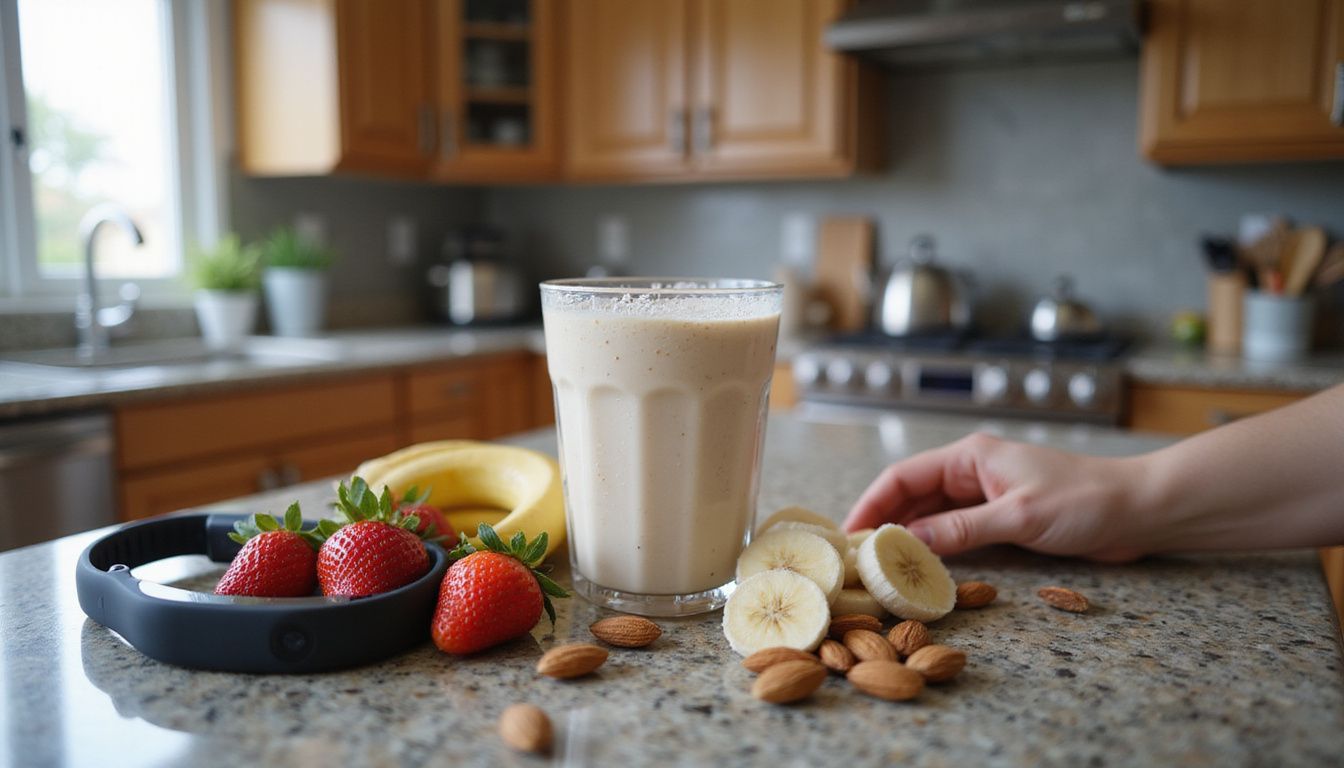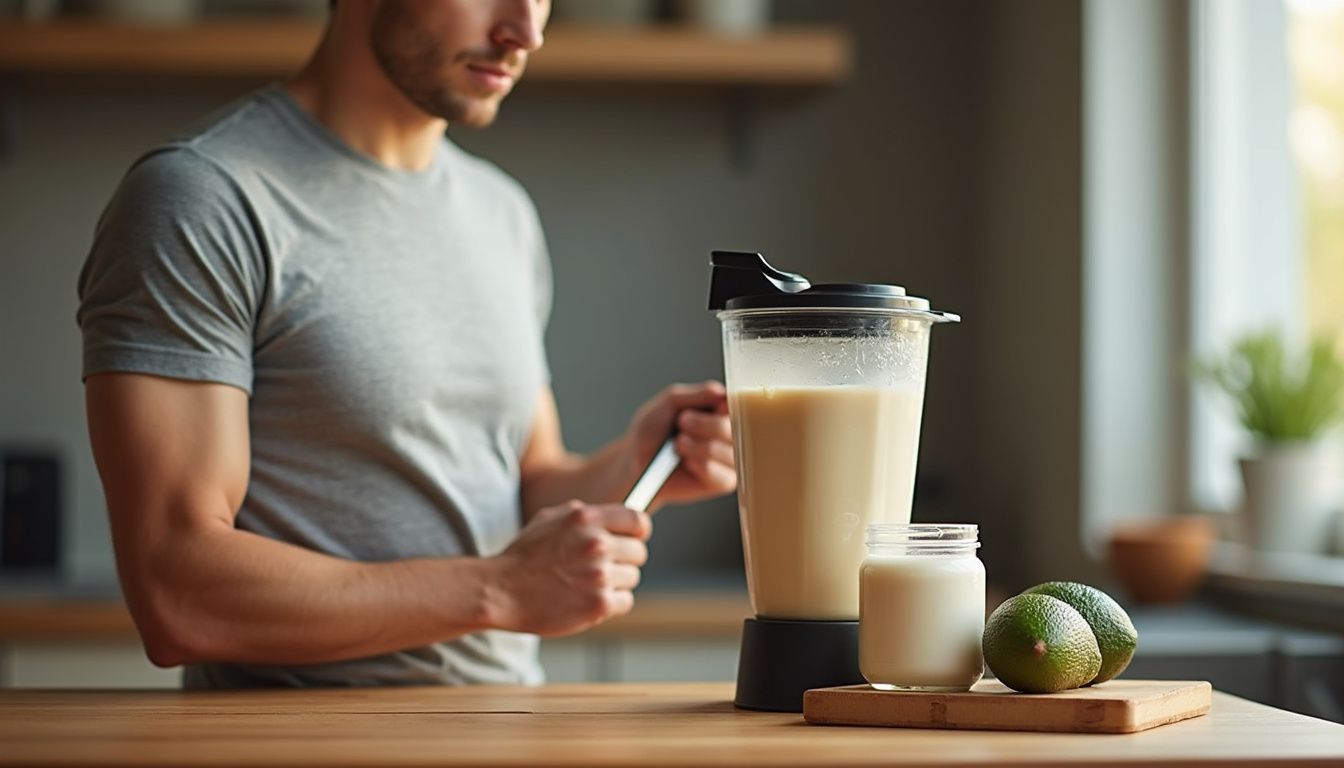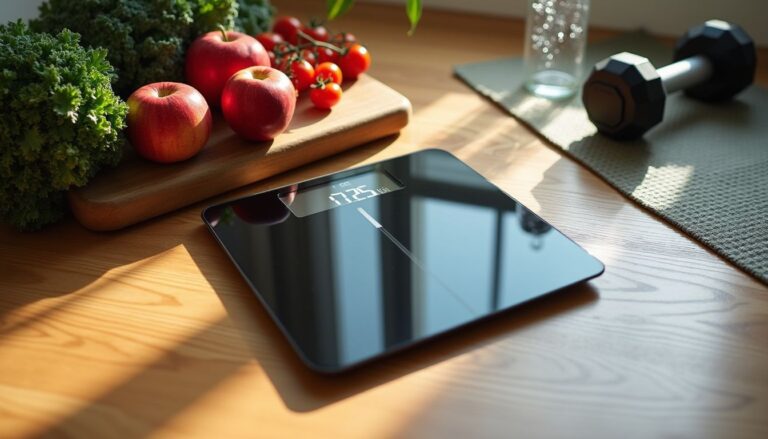Delicious High Calorie Protein Shakes For A Nutritious Boost
Our Nutrition Assistant AI Suite will transform your body. You will lose fat, get toned, and build muscle. Gain confidence and optimal health.
Gaining weight or meeting daily calorie needs can feel hard if you get full fast or lack appetite. I have been there, and small steps helped most. High calorie protein shakes make it easier to add energy and nutrients without a heavy meal.
Current research supports the use of liquid calories for weight gain and recovery because drinks are often less filling than solid foods. In this guide, I share simple tips and top ingredients like whey protein, peanut butter, and avocado to build your own high-protein smoothie routine.
You will also find quick recipes that fit many goals, from steady weight gain to workout recovery. If you want a practical way to improve nutrition, these shakes are a helpful tool.
Key Takeaways
- High calorie protein shakes provide between 400 and 1,100 calories per serving, with up to 69 grams of protein plus essential vitamins for weight gain or muscle growth.
- Drinks like BOOST VHC deliver 530 calories, 22 grams of protein, and 26 vitamins and minerals in one eight-ounce bottle for convenient nutrition support.
- Top ingredients include whey or plant-based proteins, full-fat dairy or alternatives, nut butters, healthy oils like flaxseed oil, oats, bananas, avocados, and natural sweeteners.
- Liquid calories from these shakes are often less filling than solid food, so they help increase daily intake for people with low appetite or after workouts.
- These high calorie drinks can work as meal replacements during recovery periods or when it is hard to eat enough solid food each day.

Benefits of High Calorie Protein Shakes

High calorie protein shakes give a fast calorie boost and more grams of protein per serving. I use these drinks as a simple way to hit targets and enjoy a nutrient-dense snack or meal.
How do high calorie protein shakes support healthy weight gain?
Drinking calorie-dense shakes helps me raise my daily intake without feeling stuffed. Fat contains 9 calories per gram, while protein and carbs provide 4 calories per gram. That is why adding healthy fats to a nutrition shake raises energy quickly.
I often use whole milk, Greek yogurt, or kefir to build a rich base. BOOST VHC supplies 530 calories in 8 ounces, which supports weight gain goals. One reviewer noted a rise from 96 pounds to 101 pounds after finishing a 24 pack.
Liquid calories are usually less filling than solid food, so I can add a shake between meals to lift total intake.
A single nutrition shake can add a full extra meal’s worth of energy when you need calories.
How do these shakes promote muscle growth and recovery?
After helping with healthy weight gain, high calorie shakes also support muscle repair. I combine quality proteins like whey, pea protein, or casein to supply amino acids, which are the building blocks of muscle.
For example, a bedtime casein smoothie can deliver 44 grams of protein per serving. A Mayo Clinic style recipe provides about 32 grams. BOOST VHC offers 22 grams in a small bottle, close to half a typical daily value for many adults.
I also blend Greek yogurt or silken tofu to add more protein. Pairing protein with carbs, such as oats or bananas, helps refill glycogen, the stored form of carbohydrate in muscle. Some shakes include 50 to 120 grams of carbs to speed recovery.
After training, a shake gets amino acids to muscles fast. My go-to 1,000 calorie smoothie includes whey protein at around 69 grams. It feels satisfying after a hard session and helps me hit both energy and recovery goals.
Why are high calorie protein shakes a convenient nutrient boost?
High calorie protein shakes are fast to make. I can blend milk, protein powder, peanut butter, or fruit in under five minutes. Many recipes pack key vitamins and minerals like calcium, vitamin B12, zinc, and folate into a small serving size.
For instance, BOOST VHC gives 530 calories and 22 grams of protein in 8 fluid ounces along with 26 vitamins and minerals. These drinks also help people who cannot eat large meals or who need extra energy for training.
Several brands offer lactose-free choices for sensitive diets. Many can be ordered online and shipped to your home. For grab-and-go days, that convenience matters.
Protein sources shape how well a shake works, which I cover next.
How can protein shakes help meet daily caloric and protein needs?
One high calorie nutritional drink can range from 400 to about 1,100 calories per serving. BOOST VHC gives 530 calories and 22 grams of protein in one small bottle, which fits easily into a daily plan.
I reach protein goals faster with a bedtime casein smoothie or a 1,000 calorie shake built on whey protein isolate. These options can deliver up to 69 grams of protein at once.
The Mayo Clinic style recipe provides about 608 calories and 32 grams of protein, which helps maintain weight during times of lower intake. Peanut butter shakes, smoothies with flaxseed oil or avocado, and milkshakes made with plant-based protein powder make it simple to raise both carbohydrates and fat.
Shakes also work well as meal replacements after exercise or between meals. They help me meet targets from my dietitian, whether I aim for muscle growth, weight gain, or recovery.
I use these shakes every week, sometimes twice in a day, when regular meals fall short.
Up next: what are the best protein sources like whey, pea, casein, and egg white?
Key Ingredients for High Calorie Protein Shakes
The right mix of protein, healthy fats, and carbohydrate sources builds a shake that is both tasty and calorie-dense. Here is what works well in a high-protein smoothie.
What are the best protein sources like whey, pea, casein, and egg white?
Whey protein is my top pick. It is rich in essential amino acids and supports recovery after a workout. Casein digests slowly, so I like it before bed for a steady supply of nutrients overnight.
Egg white protein is highly bioavailable and very lean. I sometimes use three quarters of a cup of liquid egg whites in a Triple Berry Smoothie to add about 18 grams of protein.
Pea, pumpkin, and brown rice proteins are solid plant-based choices. Silken tofu and soy milk can deliver up to 28 grams of protein per serving, and they blend smoothly. That makes them great for people who prefer plant-based protein or who avoid lactose.
Greek yogurt, kefir, hemp seeds, chia seeds, and soy protein isolate also boost protein while adding helpful micronutrients like riboflavin and potassium.
Which healthy fats should I add, such as avocado, peanut butter, and flaxseed oil?
Avocado creates a creamy texture and adds monounsaturated fat. A typical shake with avocado can include 13 to 27 grams of fat, which supports weight gain goals.
Peanut butter adds flavor, protein, and energy. Pairing peanut butter with cocoa powder brings a chocolate taste. Flaxseed oil is another fast way to raise calories. One tablespoon gives about 120 calories and around 14 grams of fat, along with omega-3s.
Almond butter works nicely in berry or apple shakes. Chia seeds add fiber and healthy fats, and they help thicken smoothies. Sometimes I use full-fat yogurt with whole milk for maximum calorie density.
What carbohydrate sources like bananas, oats, and honey work well?
Bananas add natural sweetness and can bring 30 to 71 grams of carbohydrates, depending on recipe size. Oats provide complex carbs and fiber that support digestion and help with fullness.
Honey supplies quick energy and a smooth flavor. Dates offer sweetness plus minerals; I might blend up to six for a rich taste. Fruit juices like orange or apple add simple sugars for a quick lift. Berries, mango, peaches, and apples bring antioxidants like vitamin C along with carbs.
For variety, I sometimes blend in graham cracker crumbs or wheat germ. They add minerals and more carbohydrate for a rounder nutrition profile.
How do vitamins, minerals, and fiber enhance protein shakes?
Vitamins, minerals, and fiber turn a basic drink into a well-rounded nutrition shake. BOOST VHC includes 26 vitamins and minerals per serving, such as vitamin C for immune support and calcium for bone health.
Adding pumpkin or berries provides antioxidants like vitamins A, C, and E. A handful of spinach increases iron and magnesium and boosts potassium. Oats or chia seeds add fiber, which supports regular digestion and helps you stay satisfied.
I often add flaxseed or hemp hearts to raise fiber and healthy fats. This keeps me full after a meal replacement shake while supporting heart health.
Delicious High Calorie Protein Shake Recipes
I like to test new smoothie recipes that deliver both flavor and a strong nutrition profile. These blends feature Greek yogurt, whey protein, fruit, and other pantry staples.
How to make a Chocolate Peanut Butter Shake with Greek Yogurt
A Chocolate Peanut Butter Shake with Greek yogurt is rich, simple, and filling. I use it after lifting because it keeps me satisfied.
- Gather 1 large banana, 3/4 cup whole milk, 3 tablespoons cocoa powder processed with alkali, 3/4 cup Greek yogurt, 1 tablespoon honey, and 1 tablespoon peanut butter.
- Add all ingredients to a blender with ice if you want it thicker.
- Use full-fat dairy to add more calories per serving.
- Choose natural peanut butter for protein, healthy fats, and a savory touch.
- Blend until smooth for a creamy texture without lumps.
- Pour into a glass. This smoothie adds a meal’s worth of nutrients, about 587 calories, 30 grams protein, 23 grams fat, and 65 grams carbs per serving.
- Drink soon after blending for the best flavor. Cocoa and banana pair well when fresh.
- This recipe works for weight gain or recovery diets and often appears in pediatric and liquid nutrition plans.
- It can be made lactose free if you use fortified plant milks.
- Check labels for added vitamins like vitamin D and other minerals to raise micronutrient intake.
What’s in a Triple Berry Smoothie with Egg Whites?
A Triple Berry Smoothie with egg whites delivers antioxidants, protein, and energy. It fits many nutrition goals.
- I add 3/4 cup liquid egg whites to boost protein without much fat.
- One-half cup strawberries, one-quarter cup blueberries, and one-quarter cup raspberries provide vitamin C, folate, and fiber per 8 fluid ounce serving.
- One avocado brings creaminess, monounsaturated fat, and extra calories with low sodium.
- Half a cup orange juice increases carbs and flavor while adding potassium.
- The smoothie supplies around 491 calories, 26 grams protein, 23 grams fat, and 45 grams carbs per serving.
- This drink is dairy free since it uses egg whites and no whey or casein.
- A pitted date can add extra sweetness without artificial syrups.
How to prepare a Green Smoothie with Greek Yogurt and Spinach
After a berry blend, I often go green for an immune-supporting shake. This Green Smoothie with Greek yogurt and spinach is fresh and energizing.
- Measure 3 cups fresh spinach for a fiber-rich base full of plant nutrients.
- Add 1 banana for natural sweetness, potassium, and creaminess.
- Pour in 1 cup pineapple for vitamin C and extra carbs to support healthy weight.
- Add 1 cup Greek yogurt to lift protein to about 28 grams per serving.
- Mix in 6 ounces fruit juice to increase carbs and smooth texture.
- Blend with ice if you prefer a chilled drink with a bright green color.
- Blend until fully smooth. It usually takes about 45 seconds.
- Each serving provides around 495 calories, 71 grams carbs, and about 11 grams fat, which suits vegetarian plans.
- You also get key micronutrients like vitamins A and B3, plus minerals such as magnesium.
This shake supports immune health thanks to its mix of fruits and greens.
What ingredients make a Coffee Protein Smoothie with Whey Protein?
On busy mornings, I want something that wakes me up and supports muscle repair. A Coffee Protein Smoothie with whey hits both goals.
- Use 2/3 cup cold brew coffee for caffeine and a cool taste.
- Add 6 to 8 ice cubes for a thick, frosty texture.
- Include 1 banana for sweetness and quick carbs.
- Mix in 1 tablespoon cocoa powder for chocolate flavor without extra sugar.
- Add 1 tablespoon almond butter to raise calories and healthy fats.
- Scoop in 1/4 cup whey protein to support recovery and weight gain.
- Include 2 tablespoons chia seeds for fiber, omega-3s, and thickness.
- Each serving gives about 385 calories with 14.5 grams of protein, 18.1 grams fat, and over 50 grams carbs.
- It keeps me alert and full for hours on a workday.
This blend supports daily calorie goals without the additives found in some ready-to-drink shakes.
How to create an Apple Cinnamon Hemp Heart Protein Smoothie
This smoothie provides about 895 calories and 32 grams of protein. I use it as a meal replacement to support weight gain and muscle repair.
- Pour 1.5 cups whole milk into a strong blender for a creamy base and high calorie content.
- Core and chop 2 medium apples for sweetness, fiber, and volume.
- Scoop in 1/3 cup oats for complex carbs and steady energy.
- Add 2 tablespoons almond butter for extra fat, protein, and flavor.
- Sprinkle in 2 tablespoons hemp hearts and 2 tablespoons chia seeds for plant-based protein and omega-3 fats.
- Toss in 1 pitted date for natural sweetness and potassium.
- Add 1 teaspoon vanilla extract and a pinch of cinnamon for aroma.
- Blend with a handful of ice until thick and smooth.
- Blend for about one minute until no chunks remain.
- Pour and enjoy right away, or chill for a quick, portable meal.
What goes into a Strawberry Banana Smoothie with Kefir?
A Strawberry Banana Smoothie with kefir works as a nutritious breakfast or snack. It combines fruit, fiber, probiotics, and a light sweetness.
- Blend 1 cup strawberries and 1 banana for flavor and vitamin C.
- Pour in 1 cup kefir to add probiotics that support gut health.
- Add 1/4 cup oats for fiber and complex carbs.
- Include ice for a cold, refreshing texture.
- Blend until smooth, adjusting oats to your preferred thickness.
- Each serving has about 403 calories, 14 grams protein, 11 grams fat, and 62 grams carbohydrates.
- Choose plant-based kefir for a dairy-free option if needed.
How to blend a Chocolate Avocado Smoothie with Flaxseed
A Chocolate Avocado Smoothie with flaxseed is rich, filling, and nutrient dense. One serving delivers about 671 calories, 36 grams protein, 27 grams fat, and 71 grams carbs.
- Pour 1 cup whole milk into a high-speed blender for a creamy base.
- Add half an avocado for healthy fats and fiber that thicken the shake.
- Drop in one banana for potassium and natural sweetness.
- Blend in 4 to 6 dates for more sweetness without refined sugar.
- Add 1/4 cup protein powder to boost protein content.
- Mix in 2.5 tablespoons cocoa powder for a deep chocolate taste.
- Add 1 tablespoon ground flaxseed for omega-3 fats and fiber.
- Finish with 1 teaspoon vanilla extract and a handful of ice. Blend until completely smooth, usually about one minute.
- I often make this after workouts or as a fast breakfast. It tastes like dessert but fuels my day.
What are the benefits of a Blueberry Smoothie with Silken Tofu?
A Blueberry Smoothie with silken tofu is a tasty way to hit protein and calorie goals. It is dairy free and supports recovery.
- Each serving provides about 493 calories, which helps raise daily energy intake.
- Silken tofu and soy milk can supply 28 grams of plant-based protein to support muscle repair.
- Blueberries add vitamin C and antioxidants that protect cells.
- The blend fits vegan diets and works for people with dairy allergies.
- With 13 grams of fat and 66 grams of carbs, it suits post-workout needs or a meal replacement.
- Honey adds natural sweetness and steady energy.
- Silken tofu creates a smooth, creamy texture that is easy to drink on the go.
- A reliable blender makes mixing fast and consistent at home.
How to make a 1,000-Calorie Smoothie with Whey Protein
Building a 1,000 calorie smoothie with whey protein is straightforward. It supports quick weight gain and intense training needs.
- Add 1/2 cup strawberries, 2 tablespoons peanut butter, 1 banana, and 1 tablespoon honey to a blender.
- Mix in 1 cup rolled oats for complex carbs and fiber.
- Add two scoops of whey protein powder to increase protein content.
- Pour in 1.5 cups whole milk for creaminess and extra calories.
- Blend on high for about one minute until smooth.
- Check thickness. Add more milk if needed.
- Pour into a large glass, or split into two servings to avoid feeling too full at once.
- The shake contains about 1,100 calories, 69 grams protein, 36 grams fat, and 125 grams carbs.
- It works well as a meal replacement or post-workout drink.
- Quality whey protein is easy to find online for steady nutrition support.
What’s special about a Pumpkin Pie Shake with Egg White Protein?
This fall-inspired shake uses egg white protein and tastes like dessert, yet it fuels recovery and weight goals.
- Each serving offers about 535 calories, 36 grams protein, 19 grams fat, and 55 grams carbohydrates.
- Egg white protein powder adds a lean protein boost.
- One cup whole milk increases calories and creaminess for healthy weight gain.
- Three tablespoons pumpkin puree add vitamins A and C for immune and eye health.
- Almond butter increases healthy fats and energy density.
- Pumpkin pie spice and cinnamon supply seasonal flavor and antioxidants.
- Graham cracker crumbs are optional for crunch and extra carbs.
- It is an enjoyable post-workout shake or meal replacement during autumn.
- Blend with ice for a smooth texture and quick nutrition.
- I make it every holiday season because it satisfies cravings and supports my plan.
Tips for Customizing Your Protein Shakes
I adjust high calorie protein shakes to match my diet and taste. Small tweaks keep each drink enjoyable and balanced.
How can I adjust sweetness using natural sweeteners like dates or honey?
I blend 1 to 6 dates to add natural sweetness and extra carbs. With honey, I usually use one tablespoon, which adds about 13 to 17 grams of sugar based on the product.
Sometimes a single date is enough in an Apple Cinnamon smoothie. Ripe bananas or fruit juices raise both flavor and energy if I need more calories.
For dessert-style shakes, graham cracker crumbs add a hint of sweetness and more carbs. Flavored protein powders or yogurts can reduce the need for extra sugar. BOOST VHC contains about 13 grams of added sugar per serving if tracking packaged sources.
What are good plant-based protein powders for vegan options?
Pea protein, brown rice protein, and pumpkin seed protein offer roughly 20 to 27 grams per serving. They are easy swaps for whey or casein in most recipes.
Silken tofu and soy milk also add quality protein to smoothies. Hemp hearts and chia seeds bring healthy fats and a bit more protein. I choose unsweetened plant milks to avoid extra sugar while keeping calories high.
How do spices like cinnamon or nutmeg enhance flavor?
Spices add warmth and depth to high calorie shakes. A pinch of cinnamon in an Apple Cinnamon Hemp Heart blend adds gentle sweetness that pairs with fruit.
Pumpkin pie spice in a Pumpkin Pie Shake gives a seasonal aroma, while a little nutmeg creates a cozy taste. Cocoa powder adds chocolate notes, and vanilla lifts natural sweetness. These spices also provide antioxidants, which is a nice bonus.
I adjust amounts to shape the flavor profile I want. Blending spreads the spice evenly so every sip tastes balanced.
What lactose-free milk alternatives work for dairy sensitivity?
Soy milk and almond milk are reliable in vegan and lactose-free shakes. Oat milk, rice milk, and coconut milk also create a creamy texture without lactose. Coconut milk is higher in calories, which can help with weight gain.
Lactose-free kefir offers probiotics without discomfort. Silken tofu blends smoothly as a dairy-free base. BOOST VHC is suitable for many people with lactose sensitivity, though it is not intended for those with galactosemia.
I adjust the amount of plant milk to reach my preferred thickness. These options make high calorie shakes accessible for many diets.
When to Drink High Calorie Protein Shakes
Timing can boost results. A well-timed shake often feels like a shortcut to steady energy.
Why drink high calorie protein shakes post-workout?
Muscles respond well to fast protein and carbs after intense exercise. Drinking a high calorie protein shake within 30 to 60 minutes helps repair muscle tissue and restore glycogen.
A typical 1,000 calorie whey smoothie offers about 69 grams of protein for fast support. Options like the Mayo Clinic style smoothie provide about 32 grams per serving. Quick preparation fits busy routines, which is why I rely on a blender after training.
Balanced recipes with both carbs and protein can speed strength gains and healthy weight goals.
Can these shakes be used as a meal replacement?
Many high calorie shakes contain 895 to 1,100 calories per serving and offer balanced macronutrients. Some provide up to 69 grams of protein, up to 125 grams of carbs, and up to 47 grams of fat.
Options such as BOOST VHC also include 26 essential vitamins and minerals. These meal replacement shakes help people with low appetite or chewing issues meet daily energy needs. They are also practical for busy days.
When eating large meals is hard, a nutrition shake can bridge the gap.
What are the benefits of drinking shakes before bedtime?
Having a protein shake before bed supports overnight muscle repair. Casein protein is slow digesting, so it feeds muscles while you sleep. My bedtime smoothie provides around 44 grams of protein and a steady stream of amino acids.
One option has about 655 calories, 31 grams of healthy fats, and 50 grams of carbs. This mix fuels your body for hours and may support hormone production and fullness through the night.
For athletes or people with high calorie needs, a nighttime shake can help meet goals by adding nutrition during rest.
Planning a post-workout shake and a bedtime shake can create a strong one-two routine for growth and recovery.
How can shakes serve as an energy-boosting snack?
Protein shakes make an easy snack that lifts energy fast. Lighter options range from about 363 to 403 calories and deliver quick carbs when I need them most. Fruit blends give a fast boost, while nuts or seeds keep the energy going.
A Coffee Protein Smoothie combines caffeine and protein for sharper focus before a workout or a long study session. I also carry a ready-to-drink option for busy afternoons. BOOST VHC packs 530 calories into just eight ounces, which works well between meals.
These choices help prevent mid-day slumps and set me up for evening activity.
Best Practices for Making Protein Shakes
I focus on taste, texture, and nutrition in every protein shake. A few small habits make a big difference.
How long should I blend ingredients for the best texture?
Blending time shapes texture and taste. I use these steps for a thick, creamy result without clumps.
- Blend at high speed for 45 to 60 seconds to smooth out powders and fibers.
- Use closer to one minute for frozen fruit or ice.
- Extend the blend for fibrous foods like spinach or oats.
- Pause and scrape the sides halfway if needed.
- Add more liquid if the shake becomes too thick during blending.
- Use short pulses at the end to clear any small chunks.
- Chill with ice for a better mouthfeel, which can also thin the shake slightly.
- Rely on a high-speed blender to avoid gritty texture.
- Drink soon after blending since shakes can thicken if they sit.
Why use fresh and high-quality ingredients?
Fresh, high-quality ingredients improve taste, safety, and nutrition. They also support long-term health goals.
- Ripe fruit and leafy greens add flavor without extra sugar or additives.
- Quality protein powders improve amino acid intake and recovery.
- Healthy fats like avocado, nut butter, and cold-pressed flaxseed oil raise calories while supporting heart health.
- Fresh produce keeps more vitamins and minerals than older items.
- Whole oats and bananas bring fiber that supports digestion and helps with fullness.
- Higher quality ingredients lower contamination risk.
- Premium choices make it easier to adapt recipes to allergies or sensitivities.
How to ensure shakes align with your dietary goals and needs?
Careful choices help each shake support your targets, from weight gain to muscle recovery.
- Track calories so each shake contributes to a surplus if your goal is weight gain.
- Pick protein powders that match your needs, such as whey for speed, casein for slow release, or plant-based protein for dairy-free plans.
- Add calorie-dense fats like avocado, peanut butter, or flaxseed oil to raise energy without too much sugar.
- Use fruits, oats, honey, and juices to lift carbs and improve taste.
- Include fiber sources like chia seeds or leafy greens for digestive support.
- Choose fortified products like BOOST VHC if you need extra vitamins and minerals.
- Swap in almond or oat milk for lactose-free needs while keeping calories high.
- Monitor macronutrient ratios with labels or an app to match your current goals.
- Sweeten with dates or similar options to stay within your calorie plan.
Conclusion
High calorie protein shakes make daily nutrition easier. Each protein shake can deliver extra calories, high-quality protein, and useful vitamins and minerals in a tasty, portable drink. These recipes help me reach weight gain goals without feeling overly full.
Simple ingredients like whey protein or plant-based protein blend well with fruit, oats, and nut butters to raise energy and flavor. Because liquid calories are gentle on the stomach, they work before or after workouts or as easy snacks between meals.
If you have a medical condition, talk with a registered dietitian or healthcare provider before using shakes as meal replacements. Guidance from the Academy of Nutrition and Dietetics and the USDA supports balanced eating patterns with enough protein, fiber, and micronutrients.
Adding high calorie protein shakes can support healthy weight gain and muscle recovery while fitting your life.
FAQs
1. What are high calorie protein shakes and how do they support nutrition?
High calorie protein shakes are blended drinks that combine concentrated milk proteins, nut butters, oats, and fruits to deliver both energy and essential nutrients. These shakes help people gain weight or recover from illness by providing a dense source of calories and complete proteins in one serving.
2. Who can benefit most from drinking delicious high calorie protein shakes?
People with higher energy needs such as athletes, individuals recovering from surgery, or those struggling to maintain weight due to medical conditions often benefit the most. For example, after my own sports injury last year, adding these shakes helped me regain lost muscle mass more quickly.
3. How much protein and calories do typical nutritious high calorie protein shakes contain?
A standard homemade shake may provide 400 to 700 calories per serving along with 20 to 40 grams of milk-based or plant-derived proteins. According to the USDA FoodData Central database (2024), combining two cups of whole milk with two tablespoons of peanut butter yields about 500 calories and over 25 grams of quality protein.
4. Are there risks associated with consuming high calorie protein shakes daily?
Consuming these nutrient-rich beverages is generally safe for healthy adults when used as part of a balanced diet; however, excess intake could lead to unwanted weight gain or digestive discomfort in some cases. It is important for individuals with kidney disease or other health concerns to consult a healthcare provider before making significant dietary changes.
Summary: High calorie protein shakes offer an efficient way for many people including athletes and patients in recovery phases to meet increased nutritional requirements through convenient blends rich in energy and complete proteins while maintaining safety guidelines based on individual health status.







